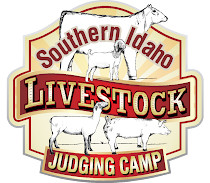Which Animal Should I Choose from the Pen?
Cindy A. Kinder, University of Idaho, Area Extension Educator
I am planning to take a market project. I know what species I have facilities for, but which animal do I choose? My goals this year are to: 1. Have my animal market ready by fair time, 2. Select an animal that is consistent with industry standards and 3. Learn and challenge myself about animal selection and feeding. If I meet my goals, my project is a success no matter where the fair judge places my animal in its quality class.
One thing I learned in my last market project was “what I start with is what I end with”. I could not change the amount of muscling my steer had, and with more muscling the steer would have looked better and been more balanced.
So this year, what do I look for in my project animal? I want my animal to produce market industry goals so I will select an animal I think will have the potential for meeting those standards (see textboxes). I know there are breed differences and differences within a breed as to how it relates to performance. Genetically I know all breeds have good animals and the producer I purchase from selects for carcass traits, so I will select the best animal no matter the color.
Besides industry goals I will look at four main qualities.
1. Muscling
Muscling is important to the meat animal industry. Heavy muscled animals produce more lean and less fat and consumers are very conscious of fat and prefer beef, pork and lamb with less fat. You can see indications of muscling: over an animal’s top, in the loin area, length of hip, width of stifle, and in the round, ham, and leg region. I will select an animal with good to excellent muscling.
2. Structure, Soundness, Balance
Strong bone and correct skeletal structure is important and essential for any animal getting to feed and water. You can observe structure in: the angle of the shoulder, levelness of top line, hip and dock, pastern and hock angle, and movement. Balance is best identified as uniformity in the appearance of muscle trimness and skeletal structure. I will select an animal with correct structure.
3. Growth & Frame, Skeletal size
Different livestock industries have ideal final weights and carcass weights. Animals can be too small and cost the industry more per pound or too large for handling facilities or most consumers. Indicators of size are: length of body, height at the hip or shoulder, and length and size of cannon bone. I will select an animal that will have good potential for growth.
4. Performance, Capacity, Volume
The amount of capacity and condition (fat) an animal has relates to its performance. Indicators of capacity and performance are width of chest floor, width across shoulder blades, rib shape, and weight per day of age. I will select an animal that stands wide, has a deep body and is not too fat.
I know that market animal programs target a specific market date (fair and sale) therefore selection of my project animal is important. My feeder animal must be in the right beginning condition (not prematurely fat, not too thin). Because as the feeding period ends it is difficult to slow down an animal’s performance in order to achieve the desired target. It is also important not to allow my project animal to fall behind schedule because it will be impossible to speed up and put on the necessary finish to be market ready at fair time. Last year I had $200 more in feed expenses because I fell behind schedule.
Which animal are you going to choose from the pen? Here are some questions you can ask yourself.
How much muscle does my animal have?
Can my animal walk correctly? As the animal gets heavier will that change?
What is the frame size of my animal: small, medium, large?
What do I think the final fair weight will be? Does that meet industry standards?
What kind of condition (fat or thin) is my animal in?
Am I ready for this year?
Beef Cattle
Subscribe to:
Comments (Atom)











